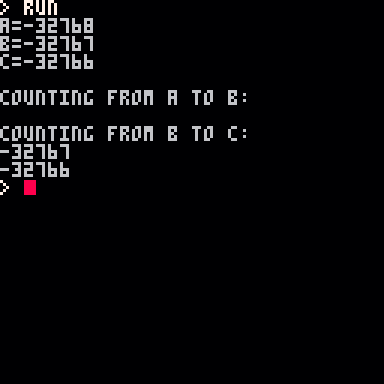Hi Zep, or whoever is reading this!
I'm playing around with Pico-8 and found a few things with the numbers that I wasn't expecting.
The lowest number in pico-8 is: 0x8000.0000 or -32768.
The highest number in pico-8 is 0x7FFF.FFFF or 32767.999 or about 32768
Keeping that in mind, doing this:
printh(abs(0x8000.0000) == 0x8000.0000) |
will print out true, the same number! Which is a negative number (-32768). I wouldn't think that abs should ever give you a negative number. I would expect the above code to print out 0x7fff.ffff!
And the other really weird thing is that these are all true statements:
printh(1/0x0000.0000 == 0x7fff.ffff) -- understandable, this is in the manual. printh(1/0x0000.0001 == 0x0000.0000) -- huh? i would expect this to be 0x7fff.ffff also printh(1/0x0000.0002 == 0x8000.0000) -- now it is a negative number!!! this should also be 0x7fff.ffff printh(1/0x0000.0003 == 0x5555.5555) -- these two are fine and make sense. :) printh(1/0x0000.0004 == 0x4000.0000) printh(1/0x7fff.ffff == 0x0000.0002) -- and this one actually makes sense too. though of course it isn't transitive or whatever. |
I found these while porting a raytracing program to Pico-8 and breaking it apart to understand it. I'm running Pico-8 on Linux. And running version 0.1.11g.

Note that limits are actually [-32768,32767]
And yeah, you'll have to live with nasty overflow & wrap around numbers.
Hint: don't get ever close to these limits :_[
(or roll your own "float" number - lua makes it "relatively" easy to do)

I guess I was thinking the built in functions should be able to handle the overflow. Who knows, maybe they shouldn't. On one side it could be a hardware constraint for the fantasy console and feeling like you're programming at a lower level.
But on the other side the divide by zero is handled/documented so why isn't the divide by 0x0000.0001 talked about/documented?
And should the absolute value of -32768 be -32768? Maybe someone has already brought this up before. I would be interested in explanations if it has already been talked about though.

I think I've found a related bug:
a = 0x8000
b = a+1
c = b+1
print("a="..a)
print("b="..b)
print("c="..c)
print("")
print("counting from a to b:")
for i=a,b do
print(i)
end
print("")
print("counting from b to c:")
for i=b,c do
print(i)
end |
should first count from -32768 to -32767, then from -32767 to -32766 ... but it doesn't:

I think the for loop is treating -32768 as +32768, too.

0x8000 is a special number, like 0x0000. Both are technically without sign, but get assigned to negative and positive in 2's complement mode just for the sake of simplicity & balance.
Just like -0x0000 == 0x0000, -0x8000 == 0x8000.
(Some people supposedly call it "the weird number", but I call it "the outpost", since it's the farthest number from the origin in 2's complement, in both directions.)
In short, it's not a bug that they can't be negated to get a different number.
HOWEVER
It DOES seem to be a bug that you can't do a for loop that involves -32768 as an endpoint. That should probably be fixed.

Yeah, and this is a bit tricky to fix. The reason is that the Lua virtual machine internally starts its “for” loops at “start - step” instead of “start” for performance reasons. Since -32768 minus 1 is +32767 which is greater than the “end” value, the VM thinks the loop is finished.
This also happens whenever “start - loop” underflows, so the following loop will not work either, even though all parameters are well within the number system limits:
for i = -30000, 30000, 10000 do print(i) end |
[Please log in to post a comment]








